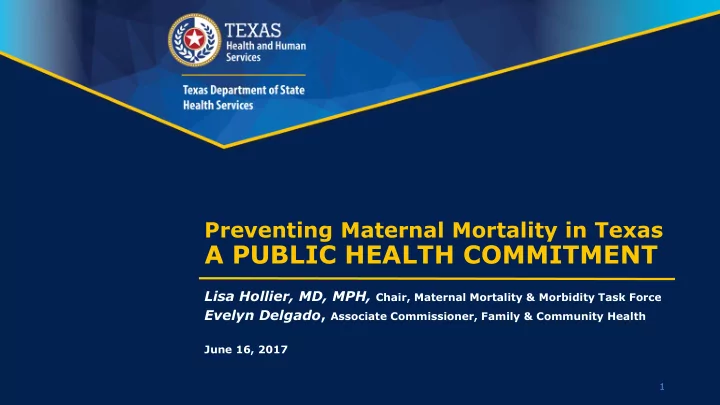

Preventing Maternal Mortality in Texas A PUBLIC HEALTH COMMITMENT Lisa Hollier, MD, MPH, Chair, Maternal Mortality & Morbidity Task Force Evelyn Delgado , Associate Commissioner, Family & Community Health June 16, 2017 1
Let us have a moment of silence for the families in Texas forever impacted by the loss of a mother 2
Overview 1) Roles & Responsibilities 2) Maternal Death Data Trends 3) Severe Maternal Morbidity Trends 4) Case Reviews 5) Key Findings to Date 6) Action Plan • More Accurate Death Data & Maternal Mortality Rate • New Legislative Charges • Need for Maternal Safety Bundles • Texas Maternal Mortality Forum 3
Roles & Responsibilities Roles • Multidisciplinary Task Force was established in 2013 and began its work in late 2014 supported by DSHS • Task Force studies and reviews cases and data trends, and makes recommendations for prevention • DSHS provides administrative support: • 1 Epidemiologist — surveillance, research, and data analytic expertise, statewide data trends, case review record requests, data collection, analysis • 1 Public Health Nurse — case review medical expertise, oversight, quality monitoring, summarizes all cases • ½ Program Specialist — coordination of logistics of Task Force, subject matter expertise for implementing recommendations 4
Roles & Responsibilities (cont’d) Responsibilities • Maternal Death Data Trends • Case Reviews — to gain a more in-depth picture of causes and risk factors related to maternal death to make recommendations for prevention 5
Maternal Death Data Trends Maternal Mortality Rate (MMR) • Number of maternal deaths occurring within 42 days of the end of pregnancy per 100,000 live births • Maternal death within 42 days is determined by coding done by CDC • CDC coding based on pregnancy status information and cause of death description on death certificate certified by physicians, medical examiners, or justices of the peace 6
Maternal Death Data Trends (cont’d) 7
Maternal Death Data Trends (cont’d) More Accurate Texas MMR • Enhanced method for identifying maternal deaths: • Linking death record to birth or fetal death within 42 days • Checking medical records for evidence of pregnancy near/at time of death • Preliminary findings suggest that enhanced method will result in significantly lower 2012 Texas MMR than MMR previously published by other researchers • Use enhanced method going forward for MMR trends and comparisons 8
Maternal Death Data Trends (cont’d) Maternal Mortality Rate and Risk Factors: Texas 9
Maternal Death Data Trends (cont’d) Maternal Mortality Rate by Racial/Ethnic Group: Texas 10
Severe Maternal Morbidity Data Trends 11
CASE REVIEWS PROCESS DSHS Data Collection MEDICAL CASE DATA CASE MATERNAL RECORDS ANALYZED & CASES SUMMARIES DEATHS REQUESTED, FINDINGS SUMMARIZED REVIEWED IDENTIFIED SCANNED, & REPORTED REDACTED DSHS Task Force DSHS 12
CASE REVIEWS (cont’d) PROGRESS Late 2014, case reviews began for 2012 (year with • highest Texas MMR) Approximately 45 of 90 cases for 2012 reviewed • PLAN FOR EXPEDITING Automating case record requests • Adopting and adapting case review data collection • system Sampling 50 percent of all maternal death cases for Task • Force review annually Contracting for medical case record redaction and • abstraction 13
Key Findings to Date • Need for more accurate death data and MMR • Risk for maternal death highest among Black women • Behavioral health issues, especially opioid use and postpartum depression often indirectly associated with maternal death • Obstetric hemorrhage and hypertension/eclampsia among leading direct causes of severe maternal morbidity with greatest preventability of maternal death 14
Action Plan More Accurate Death Data & MMR • Increase accuracy of death certificate data in new vital event registration system to reduce user error for death reporting • User training of new system encouraged by professional organizations important for preventing user error • Use enhanced method for identifying maternal deaths for more accurate MMR 15
Action Plan (cont’d) New Legislative Charges • Examine role of postpartum depression and evaluate programs • Develop best-practice guidelines and protocols for reporting and investigating pregnancy-related deaths 16
Action Plan (cont’d) Need for Maternal Safety Bundles • To address obstetric hemorrhage and severe hypertension/preeclampsia — top causes of maternal death with greatest chances of being prevented • Best-practice instructions, checklists, and supplies for hospital staff to prepare for, respond to, and prevent obstetric hemorrhage and severe hypertension during pregnancy • Bundles designed to be implemented by state’s perinatal quality collaborative, who has established relationships with hospitals • Texas Collaborative for Healthy Mothers and Babies (TCHMB) supported by DSHS-funded contract with University of Texas 17
Action Plan (cont’d) Texas Maternal Mortality Forum • To inform partners on issue of maternal mortality, develop technical planning workgroups and action plans for implementation of evidence-based initiatives • Three main workgroups: • Data Collection and Reporting • Systems of Care • Public Health Systems 18
Questions? 19
Recommend
More recommend